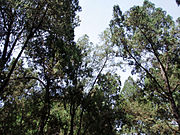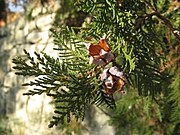Platycladus
| Китайская арборвита | |
|---|---|

| |
| Platycladus Orientalis в ее естественной среде обитания в Симатае , Великая Китайская стена | |
| Scientific classification | |
| Kingdom: | Plantae |
| Clade: | Tracheophytes |
| Clade: | Gymnospermae |
| Division: | Pinophyta |
| Class: | Pinopsida |
| Order: | Cupressales |
| Family: | Cupressaceae |
| Subfamily: | Cupressoideae |
| Genus: | Platycladus Spach |
| Species: | P. orientalis
|
| Binomial name | |
| Platycladus orientalis | |
| Synonyms[3] [4] | |
| |
Platycladus является монотипическим родом вечнозеленых хвойных , деревьев в Cupress Cupresseae , содержащем только один вид, Orientalis , также известный как китайский Thuja Platycladus [ 5 ] Восточные Арборвита [ 6 ] Китайские арборвиты , биота или восточная туаджа . Это родом в северо -восточных частях Восточной Азии и Северной Азии , [ 3 ] [ 7 ] [ 8 ] но теперь также натурализован как внедренные виды в других регионах азиатского континента.
Описание
[ редактировать ]Этот раздел в значительной степени или полностью зависит от одного источника . ( июль 2024 г. ) |
A monoecious tree, it is small, slow-growing, reaching 15–20 m (49–66 ft) and 0.5 m (1 ft 8 in) trunk diameter (exceptionally to 30 m or 98 ft tall and 2 m or 6 ft 7 in diameter in very old trees). The foliage forms in flat sprays with scale-like leaves 2–4 mm (0.08–0.16 in) long, which are bright green in colour but may turn brownish or coppery orange in winter. The cones are 1.5–2.5 cm (5⁄8–1 in) long, green ripening brown in about eight months from pollination, and have 6–12 thick scales arranged in opposite pairs. The seeds are 4–6 mm (0.16–0.24 in) long, with no wing.[citation needed]
The branches are relatively short, loosely arranged and, usually, sharply directed upwards, and the bark, brownish, is detached in narrow vertical strips. The twigs are compressed and are arranged in vertical planes. The leaves, arranged in four rows, fleshy, opposite, decussate, truncated, imbricated as adults, somewhat curved inwards, of uniform green color and with a resiniferous gland on the underside. The female cones, of pink-salmon color and later bluish-greenish when immature, centimetric and of annual maturation, are oval with 6-8 flattened, thick scales, coriaceous and provided with an apical hook.[9]
Taxonomy
[edit]Although generally accepted as the only member of its genus, it has been suggested that the closely related species Microbiota decussata could be included in Platycladus, but this is not widely followed. Other fairly close relatives are Juniperus and Cupressus, both of these genera being graft-compatible with Platycladus. In older texts, Platycladus was often included in Thuja, which is reflected in one of its common names, "oriental thuja". But it is only distantly related to the genus Thuja. Differences include its distinct cones, wingless seeds, and its almost scentless foliage.
Etymology
[edit]The binomial Platycladus means 'with broad or flattened shoots' deriving from Greek πλατύς platys 'broad, flat, level' and κλάδος klados 'branch, shoot of a tree'.[10] The qualifier orientalis refers to its native habitat in China.[11]
Distribution
[edit]It is native to northwestern China, but it is difficult to distinguish the areas where they are native safely from those where they have been introduced. It is distributed in Manchuria, Russian Far East (Amur and Khabarovsk), and now it is naturalised in Korea, Japan, India, Florida and Iran as well. It is also cultivated in many parts of the world in parks, gardens, home yards, cemeteries and for hedges.[12]
Uses
[edit]Resistant to drought, it is very often used as an ornamental tree, both in its homeland, where it is associated with long life and vitality, and very widely elsewhere in temperate climates. It is suitable for form cuts and year-round opaque hedges, but also forms impressive slender solitary trees. Several cultivars have been selected, of which 'Aurea Nana'[13] has gained the Royal Horticultural Society's Award of Garden Merit.[14]
The wood is used in Buddhist temples both for (lavairos) construction work, and chipped, for incense burning. Its twigs and leaves contain 0.12% essential oil containing pinene and probably caryophyllene.[15] Its use as a memorial tree dates back to the Zhou dynasty in China, where it was the official memorial tree of princes.[16]
Gallery
[edit]-
Habit of young plant
-
Platycladus orientalis, Morton Arboretum acc. 168-53#3[17]
-
Mature trees
-
Mature tree
-
Very young female cones
-
Immature seed cones
-
Mature cones, with seeds visible
-
Mature cones
-
P. orientalis 'Rosedalis'
-
P. orientalis 'Rosedalis' leaf
-
P. orientalis 'Semperaurea' in winter
References
[edit]- ^ Farjon, A. (2013). "Platycladus orientalis". IUCN Red List of Threatened Species. 2013: e.T31305A2803944. doi:10.2305/IUCN.UK.2013-1.RLTS.T31305A2803944.en. Retrieved 19 November 2021.
- ^ "Platycladus". Germplasm Resources Information Network. Agricultural Research Service, United States Department of Agriculture. Retrieved 2008-02-19.
- ^ Jump up to: a b "Platycladus orientalis". Plants of the World Online. Royal Botanic Gardens, Kew. Retrieved 21 August 2024.
- ^ "WSCP, the last web-archive snapshot before migration to POWO (Archive copy)". 2022-05-06. Archived from the original on 2022-05-06.
- ^ BSBI List 2007 (xls). Botanical Society of Britain and Ireland. Archived from the original (xls) on 2015-06-26. Retrieved 2014-10-17.
- ^ USDA, NRCS (n.d.). "Platycladus orientalis". The PLANTS Database (plants.usda.gov). Greensboro, North Carolina: National Plant Data Team. Retrieved 7 October 2015.
- ^ "WSCP, the last web-archive snapshot before migration to POWO (Archive copy)". 2022-10-15. Archived from the original on 2022-10-15.
- ^ Fu, Liguo; Yu, Yong-fu; Adams, Robert P.; Farjon, Aljos. "Platycladus orientalis". Flora of China. Vol. 4 – via eFloras.org, Missouri Botanical Garden, St. Louis, MO & Harvard University Herbaria, Cambridge, MA.
- ^ Kremer BP, Trees, Editorial Blume, Barcelona, 1986, Thuja orientalis L., p. 78
- ^ πλατύς, κλάδος. Liddell, Henry George; Scott, Robert; A Greek–English Lexicon at the Perseus Project.
- ^ Harrison, Lorraine (2012). RHS Latin for gardeners. United Kingdom: Mitchell Beazley. p. 224. ISBN 9781845337315.
- ^ Armin Jagel, Veit Martin Doerken: Morphology and morphogenesis of the seed cones of the Cupressaceae - part II: Cupressoideae. Bull. CCP 4 (2), 2015, pp. 51-78
- ^ "RHS Plant Selector - Platycladus orientalis 'Aurea Nana'". Retrieved 6 February 2021.
- ^ "AGM Plants - Ornamental" (PDF). Royal Horticultural Society. July 2017. p. 79. Retrieved 2 May 2018.
- ^ Armin Jagel, Thomas Stützel: Studies on the morphology and morphogenesis of the seed cones of Platycladus orientalis (L.) Franco (= Thuja orientalis L.) and Microbiota decussata Kom. (Cupressaceae) . Bot. Year syst. Bd. 123, 2001, pp. 337-404.
- ^ Li, Hui-Lin (1974). The Origin and Cultivation of Shade and Ornamental Trees. Pennsylvania, United States: University of Pennsylvania Press. p. 20. ISBN 0-8122-1070-0.
- ^ Cirrus Digital: Platycladus orientalis Morton Arboretum accession 168-53#3
Общие ссылки
[ редактировать ]- База данных Gymnosperm - Platycladus orientalis
- Дендрарий Виллардебель - Platycladus Фотографии конуса
- Хвойные по всему миру: Platycladus Orientalis-Восточный Арборвита Архивировал 2013-09-29 на The Wayback Machine .
- "Туджа Ориенталис" . Растения на будущее .


![Platycladus Orientalis, Morton Arboretum Acc. 168-53#3 [17]](http://upload.wikimedia.org/wikipedia/commons/thumb/e/e0/Platycladus_orientalis.jpg/135px-Platycladus_orientalis.jpg)








